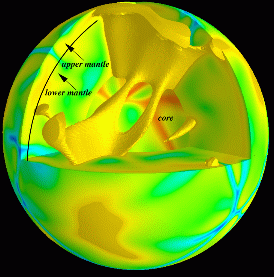Mantle Convection
Simulation & Visualization


While gradual in human terms, the vigor of sub solidus mantle convection is impressive by any standard. Indeed the Rayleigh number of the mantle, which quantifies its convective instability, is estimated to range between 10exp7 and 10exp9 (ten thousand to a million times the value at which convection begins) yielding flow velocities of 1-10 cm/year. Plate tectonics, the piecewise continuous movement of the Earths surface, is the prime manifestation of these slow deformational processes, but ultimately all large scale geological activity and dynamics of our planet, such as earthquakes, mountain building or the opening and closure of major ocean basins is the result of sub solidus convection within the mantle. Earths atmosphere may also be affected periodically by mantle processes through large volcanic outbursts, the so-called flood basalt events. These major igneous eruptions, which are accompanied by massive release greenhouse gases are speculated to be responsible for climatic changes in geologic history.
A key problem for researchers trying to understand Earths mantle convection has been to achieve modeling capabilities sufficient to represent the multitude of spatial length scales that characterizes the mantle. Such length scales may range from the depth of continents and oceanic plates (100km) to the depth of the mantle itself, demanding 10-100 million numerical grid points to resolve the mantle volume on scales of 50 km or less. The resulting computational problem has been largely untractable on conventional sequential computers, as it is necessary to follow the time evolution of pressure, temperature and velocity over the entire volume, requiring Gigabytes of memory and computational speeds of many Gigaflops. However, such problems are well in reach of modern parallel computers, such as the multiprocessor Cray T3D system.
To study high resolution models of mantle convection, we have used a message passing version of the 3-D spherical mantle dynamics code TERRA, which runs on the 256 processor CRAY T3D at the Advanced Computing Laboratory, (ACL) at Los Alamos National Labrartory. On this machine our numerical modeling code shows excellent parallel performance, displaying a communication overhead of less than ten percent. The computational memory afforded by the T3D has allowed us to investigate convection employing a numerical grid of more than 20 million finite elements. We are thus able to resolve a large range of dynamical length scales within the mantle. However, displaying this wealth of simulation data has been a formidable challenge in itself. To address this problem, we employ a parallel renderer on the T3D, that allows for both a rapid and high resolution display of simulation details as well as the ability to access and post-process data on the very platform that has been used to generate this data. The ability to display even fine simulation details, such as the very localized generation and evolution of thermal structures along major boundary layers greatly enhances the physical interpretation and presentation of these new high resolution convection experiments.
A rather unique property of the mantle fluid is the strong dependence of its viscosity (or stiffness) on both temperature and pressure. While realistic models of mantle convection in 3-D spherical geometry with strongly temperature dependent viscosity are still prohibitive, we have investigated the reaction of the mantle fluid to a radial increase in its viscosity. Such increase may be caused by changes of material properties with depth, as the major mantle minerals undergo crystalline phase changes with increasing pressure. We find that the pattern of convection changes from isolated point-like downwellings, to long linear structures that descend from the colder surface and fall into the interior of the mantle fluid. This surprising change in behavior, is much alike to the style of convection on Earth, where the long linear subduction zones surrounding the pacific are presumed to be the major areas of downwellings into the mantle. We speculate that the pattern of convection in Earths mantle might be strongly influenced by such depth dependent properties.